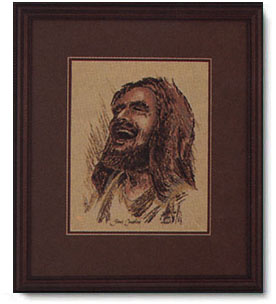Tuesday, January 8, 2008
There is no undisputed historical depiction of Jesus.
The most common illustration are Christian icons. Images flourished in Medieval art. Most surviving images of Jesus have in common a number of appearance traits which are now almost universally associated with Jesus despite lack of evidence for the accuracy of these depictions.
No detailed physical description of Jesus is contained in any of the canonical Gospels. During the Roman Empire's persecution of Christians, Christian art was necessarily furtive and ambiguous. The earliest surviving Christian art comes from the late 3rd and early 4th centuries on the walls of Christian tombs in the catacombs. Here, and only here, Jesus is portrayed in two different ways: older, bearded and robed and another as a bare faced youth holding a wand. He uses the wand to change water to wine, multiply the bread and fishes, and raise Lazarus. When pictured healing, he only lays on hands. The wand is thought to be a symbol of power. The bare faced youth with the wand may indicate that the Jesus was thought of as a user of magic or a wonder worker by some Early Christians.
There is also the Shroud of Turin, which appears in history in 1353 and which some have speculated is the same image as the Mandylion of Edessa, which disappeared in the wars surrounding the fall of the Byzantine Empire shortly before then. Controversy still surrounds the claims made for the Shroud of Turin.
There are also icon compositions of Jesus and Mary that are traditionally believed by many Orthodox to have originated in paintings by Luke the Evangelist.
Christian depiction of Jesus
Subscribe to:
Post Comments (Atom)
Blog Archive
-
▼
2008
(107)
-
▼
January
(26)
- "God Defend New Zealand" is one of the national ...
- Tourism in Melbourne, Australia, is an important...
- This is a list of recognized hooligan firms or f...
- In cooking, a consommé is a type of soup that is...
- Conservation is the profession devoted to the ...
- Southeastern is a train operating company in the...
- Common knowledge is what "everybody knows", us...
- François Couperin (French IPA: [fʀɑ̃'swa ku'pʀɛ̃...
- The Wadden Sea (Vadehavet in Danish, Waddenzee...
- The Polish Cathedral style of North-American Ca...
- This article gives an overview of liberalism in ...
- Detective Chief Inspector Gill Templer is a de...
- Biography Emmeline; or The Orphan of the Castle...
- Badí' (Arabic: ﺑﺪﻳﻊ)(1852 - 1869), was the ti...
- Tholeiitic basalt is an igneous rock, a type o...
- Federico Fellini (January 20, 1920 – October 31,...
- The Equal Rights Amendment (ERA) was a proposed ...
- Cromartyshire (Siorrachd Chromba in Gaelic) was ...
- For the video game see Tomorrow Never Dies (vide...
- Fairmont The Queen Elizabeth (commonly called ...
- The Varsity chain of forty bars is owned and o...
- There is no undisputed historical depiction of J...
- Biography Born in Norristown, Pennsylvania, Boyl...
- Coordinates: 55°01′55″N 1°33′21″W / 55.0318, -...
- Sonic Theater is a channel on the XM Satellite...
- Reverend John Jamieson, D.D. (March 3, 1759 – ...
-
▼
January
(26)
 A
A  Lefthit
Lefthit
No comments:
Post a Comment